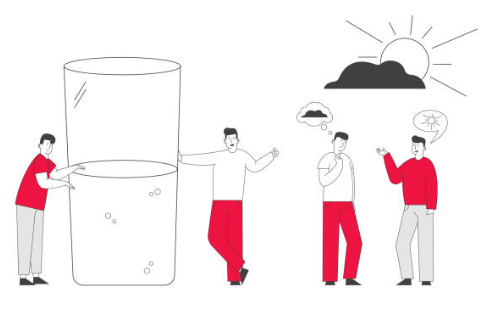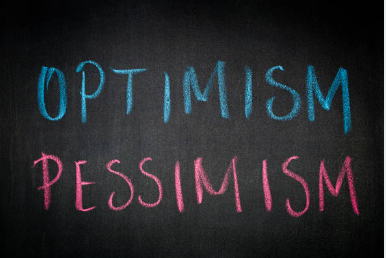Optimism vs. Pessimism
Optimism and pessimism are two opposing viewpoints. The optimist points out the things that are going well and the pessimist sees what needs to be changed or improved. If pessimism were to be the dominant mindset, people would not make any progress and would always see how things can be improved.

Selfpause Affirmation App
Download the app to get 1,000’s of affirmation meditations and everything you need to write, record and listen to your own.
Optimism

Optimism is a positive outlook toward life, while pessimism is an attitude of disbelief and discontent. Pessimists often view life as a series of problems, focusing on their shortcomings and flaws. They find it annoying to be around optimistic people, and engage in negative self-talk. They tend to believe that everything bad will happen, and they would rather keep their status quo than attempt to achieve something great.
One study found that students who were optimistic had higher grades than those who were pessimistic. They also experienced less depression, improved relations with teachers, and better self-esteem. However, the relationship between optimism and GPA is not clear. There are many variables associated with optimism, and the results from various studies are not necessarily conclusive.
Being optimistic is a positive attitude that allows us to face the challenges of life with enthusiasm and vigor. Optimistic people have plans for the future and don’t hold back from dreaming. They also bounce back from disappointments better than pessimists.
A study of men found that people with dispositional optimism were less likely to develop depression. In fact, optimism was associated with improved mental health in older men. However, it is important to remember that this doesn’t mean that we should be overly optimistic. Rather, it means that we should limit the negative impact of negative thinking on our health.
Optimistic people believe in the goodness of people and the value of their experiences. Pessimistic people, on the other hand, see obstacles as burdens that prevent them from achieving their goals. The difference between optimistic and pessimistic people is striking, and the difference is often surprising.
If you want to overcome pessimism, you need to learn how to change your mindset. Dr. Martin Seligman outlines several practical techniques in his book, “Learned Optimism.” It’s easy to learn and apply to your everyday life.
Pessimism

Pessimism and optimism are two psychological states that are influenced by our attributional style and perception of past events. Our positive or negative interpretations of past events shape our perceptions and feelings about future events. People who are optimistic attribute positive outcomes to circumstances that are within their control. Pessimists, on the other hand, blame their failure on something external to themselves.
Despite these differences, the two states are complementary, and the ability to live a positive life is an important characteristic of both. Pessimism, on the other hand, can be detrimental to our overall health. Optimism is a disposition to believe that life will work out in the long term, while pessimists believe that the world will only get worse over time. Despite this difference, many studies have shown that people who are optimistic are more successful and enjoy better relationships than their pessimist counterparts.
Optimism is related to the belief that the world is fundamentally good, and that life has meaning. Pessimism, on the other hand, involves a belief that people are essentially evil and that life is without meaning. Pessimists tend to focus on their own personal shortcomings and dislike those who are cheerful.
Optimism and pessimistic tendencies have many psychological and physiological effects. Those who are more pessimistic tend to have worse health, whereas those who are more optimistic tend to live longer. Optimistic people may have trouble dealing with stressful situations.
Optimists tend to focus on the positive aspects of life, while pessimists tend to focus on the negative aspects. Optimists, on the other hand, seek to find the silver lining in every situation. When things do not go their way, pessimists will try to avoid them.
Pessimism and optimism affect the aggregate economy in important ways. For instance, increased pessimism reduces current demand and lowers overall consumption over time. Moreover, it reduces firms’ incentives to reduce prices. As a result, output declines.
Optimistic

Optimism is beneficial to one’s physical and mental health. Studies show that people who are optimistic live longer than those who are pessimistic. They are also more likely to achieve success in their career and are more satisfied with their lives. Furthermore, optimism helps a person turn disappointments into motivation.
The word optimism comes from the Latin word ‘optimus’, which means “the best thing.” According to the Oxford English Dictionary and Wikipedia, optimism refers to the construction of a situation or event in a positive light. Pessimism, on the other hand, looks at events from a pessimistic perspective.
While pessimism is the opposite of optimism, it is also useful in some situations. For instance, people who are more optimistic earn more money and are more likely to get promoted. Optimists also tend to have better knowledge about life, which can affect their financial results.
The key difference between pessimists and optimists is in how they approach life. Pessimists tend to see negative events as isolated incidents, while optimists tend to see them as part of life’s larger picture. Pessimists focus on everything as a negative experience, and their negative outlook spreads to other areas.
Pessimists see negative circumstances as part of their destiny and see them as damaging. Rather than reacting negatively, a pessimist should reflect on the situation and visualize the next step toward improvement. They should also make sure that the negative event doesn’t affect other aspects of their lives.
Research has shown that people with a pessimistic mindset often fail to work for things they desire. For example, they don’t prepare for interviews or dress appropriately for dates. They don’t even ask for a raise. Alternatively, people with an optimistic mindset find ways to make a bad situation positive by looking for an advantage in it.
Optimists are more likely to live longer than pessimists. They have fewer illnesses and are less likely to require long-term care. They have lower rates of heart disease and cancer. Optimists also tend to be healthier overall. In addition to being more resilient, they are also more likely to reach their goals.
Pessimistic

Pessimists tend to have a more realistic view of the world than optimists. This is because pessimists experience both positive and negative events and are therefore grounded in their outlook on life. Their point of view is also influenced by their own experiences. For example, if they have been involved in several bike accidents, they may think that driving is safer than biking. However, if they have a positive experience, they may have a different view.
Pessimism can also be associated with machismo – a belief that pessimistic views are not for weaklings. This objection is often related to the idea that pessimism can encourage inertia. However, this argument can only be used when pessimism is too extreme.
Optimism is a positive mindset about the future. Optimistic people believe that everything will be good. Optimists expect things to go their way, whereas pessimists believe the opposite. An optimist will believe that things will turn out well even if the results are negative.
Optimists focus on what is going right and strive for the best possible outcome. Pessimists often see the worst in people, but this doesn’t mean they dislike them; it simply means that they are not optimistic about the future. Pessimists also tend to be less likely to procrastinate. They are also more realistic about the work-life balance.
Pessimists and optimists share some common views on climate change mitigation. They generally agree on the need for science-based, empirical evidence in order to create a realistic future. However, they differ in their outlook on the use of different energy sources. While many optimists focus on green technologies already available, others argue for geoengineering, which aims to reflect solar radiation back into space.
Pessimistic attitudes about climate change are influenced by political ideology. While some pessimists see all possible scenarios as bad, others see only possible outcomes. This diversity is attributed to the fact that climate change is often a poorly understood phenomenon. It is also due to differences between people’s evaluative assumptions and scientific climate models.
Our Top FAQ's
Optimism is the tendency to have a positive outlook on life, to expect good things to happen, and to view challenges and setbacks as temporary and solvable. Pessimism, on the other hand, is the tendency to have a negative outlook on life, to expect bad things to happen, and to view challenges and setbacks as permanent and insurmountable.
A person’s level of optimism or pessimism can affect their thoughts, emotions, and behaviors in a number of ways. Optimistic individuals may be more likely to approach problems with confidence and persistence, to feel positive emotions like happiness and hope, and to engage in proactive behaviors that help them achieve their goals. Pessimistic individuals, on the other hand, may be more likely to approach problems with doubt and resignation, to feel negative emotions like fear and despair, and to engage in passive behaviors that hinder their progress.
The potential benefits of being optimistic include better mental and physical health, higher levels of resilience and self-esteem, and greater success in achieving personal and professional goals. The potential drawbacks of being pessimistic include increased risk of depression and other mental health problems, lower levels of resilience and self-esteem, and reduced success in achieving personal and professional goals.
Both optimism and pessimism can be influenced by a person’s life experiences, environment, and personal characteristics, and it is possible for a person to change their level of optimism or pessimism over time. While some people may be naturally more optimistic or pessimistic, research suggests that optimism and pessimism are not fixed personality traits and can be modified through various methods, such as cognitive-behavioral therapy and positive psychology interventions.
There are a number of strategies that a person can use to develop a more optimistic outlook on life. Some suggestions include:
- Focusing on the positive aspects of a situation rather than the negative
- Seeking out and engaging in activities that bring joy and meaning to life
- Seeking support from friends, family, or a mental health professional when facing challenges
- Practicing gratitude and expressing appreciation for the good things in life
- Setting achievable goals and working towards them with determination and perseverance
